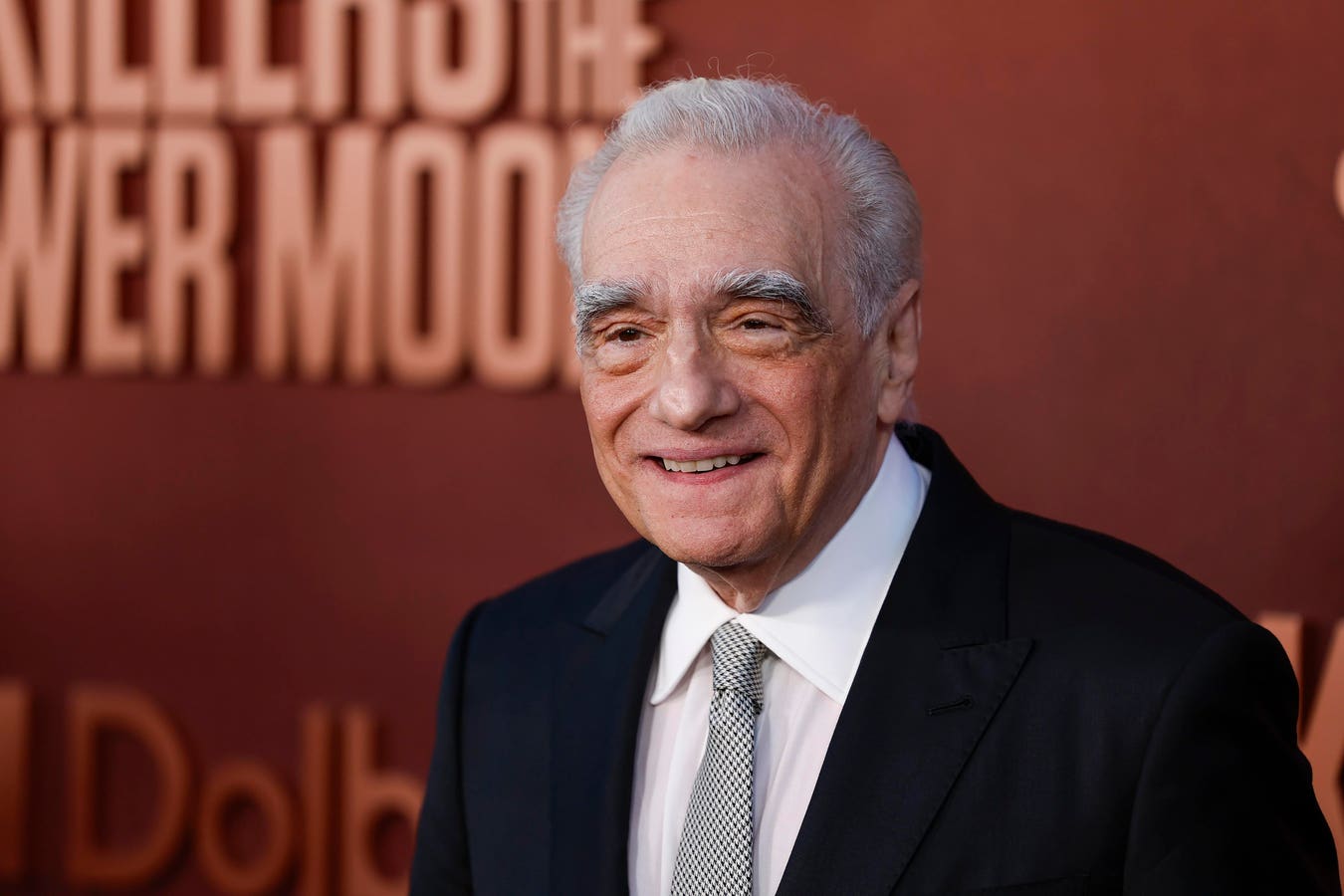Whether it’s the ones between the film’s lead characters or the actors who play them, relationships drive legendary filmmaker Martin Scorsese’s latest acclaimed opus, Killers of the Flower Moon.
An adaptation of David Grann’s 2017 book, it tells the true story of a series of murders of members of the Osage Nation during the 1920s in Oklahoma that happened after oil was discovered on tribal land. Leonardo DiCaprio leads the cast as Ernest Burkhart, Robert De Niro as his uncle, William King Hale, and Lily Gladstone as Ernest’s Native American wife and member of the Osage, Mollie Burkhart. Killers of the Flower Moon lands in theaters on Friday, October 20, 2023.
“Robert and I were teenagers together,” Scorsese called as he spoke to a select bunch of journalists the morning after the film’s premiere at Hollywood’s Dolby Theatre. “He’s the only one who really knows where I come from, the people I knew, and that sort of thing.”
The director revealed they had what he described as “a real testing ground in the 70s” where the pair “tried everything” and found that they trusted each other. He added, “It’s all about trust and love. It’s what it is. And that’s a big deal.”
It was De Niro who put DiCaprio on Scorsese’s radar.
“He told me he had worked with this kid, Leo DiCaprio, a little boy, in This Boy’s Life and he said, ‘You should work with this kid sometime.” It was just casual,” the filmmaker recalled. “He rarely gave recommendations. Years go by, and I’m presented with Leo, with Gangs of New York, and we work together. He made Gangs possible, actually. He loved the pictures I made, and he wanted to explore the same territory. And so we developed more of a relationship when we did The Aviator.”
Scorsese has worked with both actors several times over the years. However, Killers of the Flower Moon is the first time since This Boy’s Life that DiCaprio and De Niro have starred in a film together.
Towards the end of making The Aviator, Scorsese noticed “a kind of something happening, a maturity with him, I’m not quite sure, but we really clicked in certain scenes,” he added. “That led to The Departed, and then that became much closer.”
The filmmaker, who has also made Shutter Island and The Wolf of Wall Street with DiCaprio, now has a deep kinship with the actor, similar to the one he has with De Niro, despite a significant age difference.
“We really found out that even though there’s 30 years difference (between us), he has similar sensibilities,” Scorsese explained. “He’ll come to me and say, ‘Listen to this record,’ and it’s Louis Jordan and Ella Fitzgerald. I grew up with it. He’s not bringing me anything new, but he likes it.
“He’ll call me and say, ‘You know, I had a cold, and I was looking at Criterion films, and, you know, I wanted to catch up on some of these classics, and I saw this incredible movie. It’s a Japanese picture called Tokyo Story. Did you ever see it?’ This was last year,” he continued. “I said, ‘Yeah. I mean, it took me a few years to catch up.’ That’s very interesting to me to be open that way to older parts of our culture, newer parts of our culture, of course, and his curiosity about other people and cultures. There’s a trust. Even if we can’t get it right away, we know we’ll come up with something.”
To illustrate the point while pulling the stream of consciousness back around to his latest film, Scorsese recalled a scene in Killers of the Flower Moon where that process came to the fore.
“There’s a scene between Leo and Bob in the jail at the end. That scene was finally written a few days before we shot it,” he recalled. “We had said so much, and it could have gone so many different ways, but what does the picture really need? How much more is there for them to say to each other after all that’s happened, you know? And so we went that way.”
The director, who also produced and co-wrote Killers of the Flower Moon, recalled a similar interaction on The Wolf of Wall Street set, where DiCaprio “came up with wonderful stuff that was outrageous, and so I pushed him.”
“He pushed me, then I pushed him more, then he pushed me, and suddenly (laugh) everything was wild, you know? It’s really quite something. He had good energy, too, on the set. That was also very important because, in the mornings, I’m not really good,” Scorsese mused. “I’d get on set, and then I’d see him or Jonah Hill or him and Margot Robbie, and suddenly they’re all like, “Hey.” I’d say, “Okay, let’s work,” he laughed.
Staying with the importance of trust, one thing Scorsese wanted to do with Killers of the Flower Moon was to build that connection with the members of the Osage Nation he involved and consulted in the film’s production.
They were naturally cautious,” he admitted, keen for the Osage he wanted to avoid cliches. “I had to explain to them I’m going to try and deal with them as honestly and truthfully as possible. We weren’t going to fall into the trap. What I didn’t understand the first couple of meetings was that this is an ongoing situation, an ongoing story out in Oklahoma.”
“In other words, these are things that weren’t discussed in the generation I was talking to. This happened to the generation before them or before them, and the descendants are still there. Several people pointed out that you have to understand a lot of the White guys there; many European-Americans, particularly Bill Hale, were their good friends, and people didn’t believe at the time that Bill would be capable of such things.”
Scorsese met and had dinner with relatives, including Margie Burkhart, a relative of Ernest Burkhart, played by DiCaprio in the movie.
“She got up and talked about the fact that one has to remember. After she saw Silence, that sort of (made her) a little more comfortable with me doing this,” the director said. “She said we have to remember that Ernest, her ancestor, loved Mollie, and Mollie loved Ernest. It’s a love story. And so, ultimately, what happened was the script shifted that way, and it became gritty. That’s when Leo decided to play Ernest instead of Tom White.”
The role of White, a Bureau of Investigations agent sent by Washington to investigate the Osage Nation deaths, went to Jesse Plemons. “Instead of from the outside coming in and finding out who done it, in reality, it’s who didn’t do it. It’s a story of complicity,” Scorsese said.
Killers of the Flower Moon was filmed on location in Oklahoma, something the filmmaker was adamant about. The first time he visited the state was in 2019 when he was finishing up The Irishman, which also starred De Niro. He managed to make two trips before Covid hit in early 2020.
The reality of the environment he and the cast and crew would be working in came as a shock and created a learning curve, even for someone as experienced as Scorsese.
“I don’t understand weather that much or where the sun is when you’re on the set,” he recalled. “I was very surprised to learn that it set in the West. I was driving down Sunset Boulevard one time about 30 years ago and saw the sun setting. And I said, ‘That’s great. It’s Sunset Boulevard. The sun sets in the west. Now I get it.’ Anyway, when I got there, all I can tell you is those prairies are quite something. They open your mind and your heart; they’re just beautiful. So, I said, ‘Where do I put the camera at this point? How much of the sky? How much of the prairie? Should it be 1.85, or should it be 2.35? We got to go 2.35. I want to see more of this land.’ Then I began to realize the land itself could be sinister.”
Being on location helped Scorsese embrace and connect with the film set 100 years ago and how different those times were.
“This a place where you don’t need the law,” the filmmaker mused. “You have the law, but the law isn’t working that way. You can make the law work for you if you’re smart enough, as we know now, and many people do. What I mean by that is that it’s still a wide-open territory, and it can shift to being very sinister. What I wanted to capture, ultimately, was the very nature of the virus or the cancer that creates this sense of a kind of easygoing genocide. That’s why we went with the story with Mollie and Ernest because that’s the basis of the love. The love is the basis of trust. So, when there is betrayal that deep, and we know for a fact that it was that way, there’s our story.”
Read the full article here





